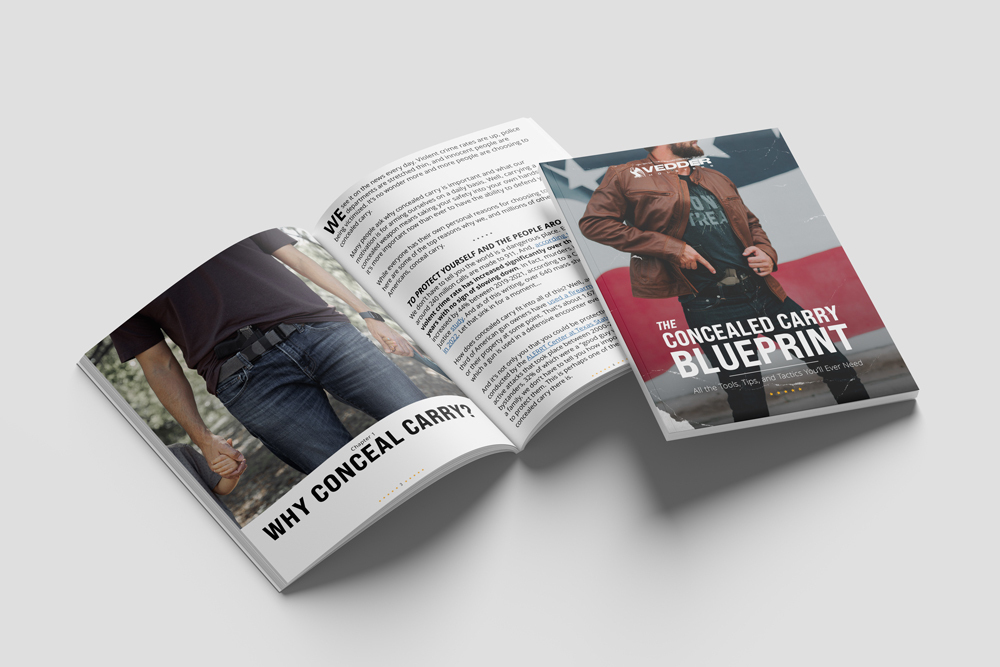Appendix Carry: Complete Guide
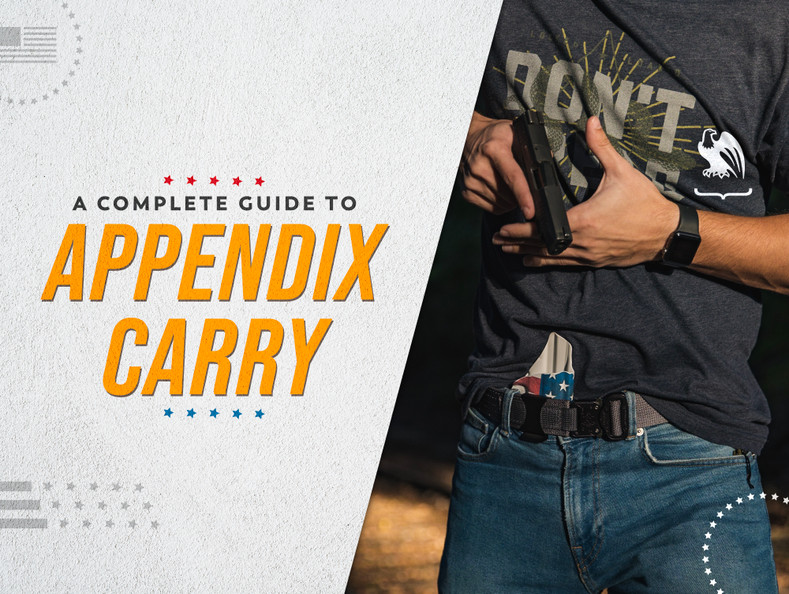
Appendix, AIWB, 1-2 o’clock, no matter what you call it, you’ve heard of this popular concealed carry position. But what exactly does it mean to carry appendix, and is it a tactic you should consider?
Appendix carry is typically concealed inside the waistband in the 1-2 o’clock position – or right in front of your hip. The carry method has gained popularity over the years for being comfortable and easy to access, though it is not without its share of controversy.
As with all concealed carry locations, so long as you train consistently, carry the right holster, and adjust it properly, carrying AIWB is just as safe and effective as anything else.
We have a lot to cover, so, without further ado, let's dive into the ins and outs of this common concealed carry method.
Products Mentioned In This Article
What is Appendix Carry?
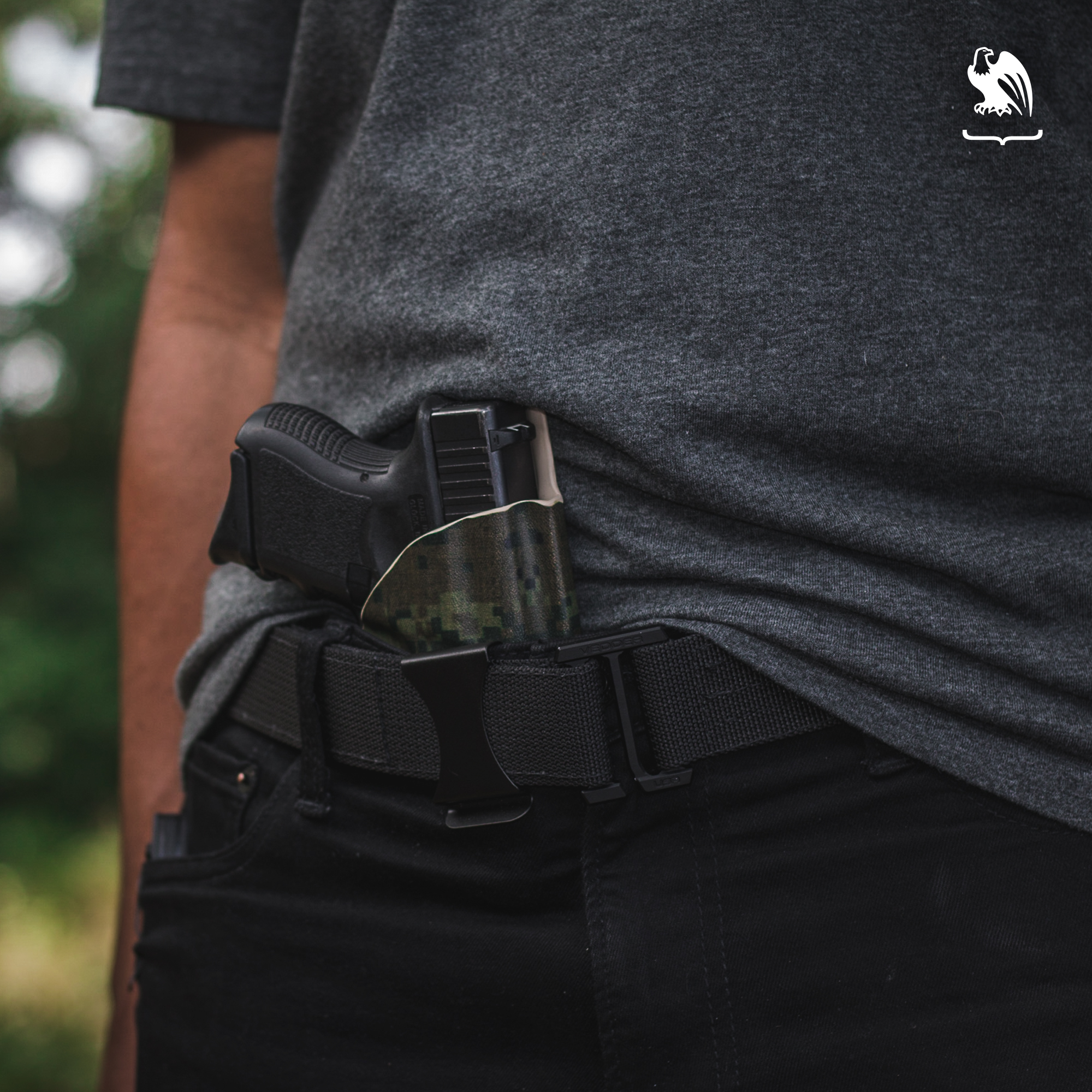
Before we get into the drama, let’s talk about what carrying appendix means exactly.
Appendix carry, or the 1-2 o’clock position (10-11 o’clock for lefties), means carrying your pistol on your dominant side in the space between your belly button and hip bone, or that space between your pant button and front pocket. Its location is (vaguely) in the region where your appendix is, hence the name.
Because this position is almost always carried inside the waistband, it is also often referred to as AIWB carry.
People have been carrying appendix for as long as we’ve been carrying pistols, according to an article by the National Rifle Association. If you think about most mobsters in the movies, you can probably picture them carrying a revolver in the front of their trousers, essentially what we now call appendix carry. At the time, it just made the most sense.
“It’s a perfectly logical place to put a weapon, because our arms naturally hang in that region and it allows quick access to whatever object you’re carrying at that position,” the NRA article reads.
For a time, modern trainers and influencers discouraged AIWB, recommending the 3-4 o’clock position instead. It wasn’t until renowned firearms trainer Todd Louis Green began advocating for and teaching about safe appendix carry that it became more popular again.
Though Green is often credited with bringing about the resurgence of AIWB carry, the rise of the internet also played a part in spreading the message on how to carry in the appendix position responsibly, which led to the recent boost in people using this carry method.
But even though many people today carry appendix and love it, a large number refuse to do so either because they find it uncomfortable or due to safety concerns.
In fact, the fear of accidentally shooting yourself in the groin and losing certain *ahem* appendages is the driving force behind the controversy surrounding AIWB carry. This fear has become so widespread that some internet dwellers have even referred to it as “junk carry” for this very reason.
So, let’s address this issue right off the bat. Is carrying appendix safe?
Is Appendix Carry Safe?
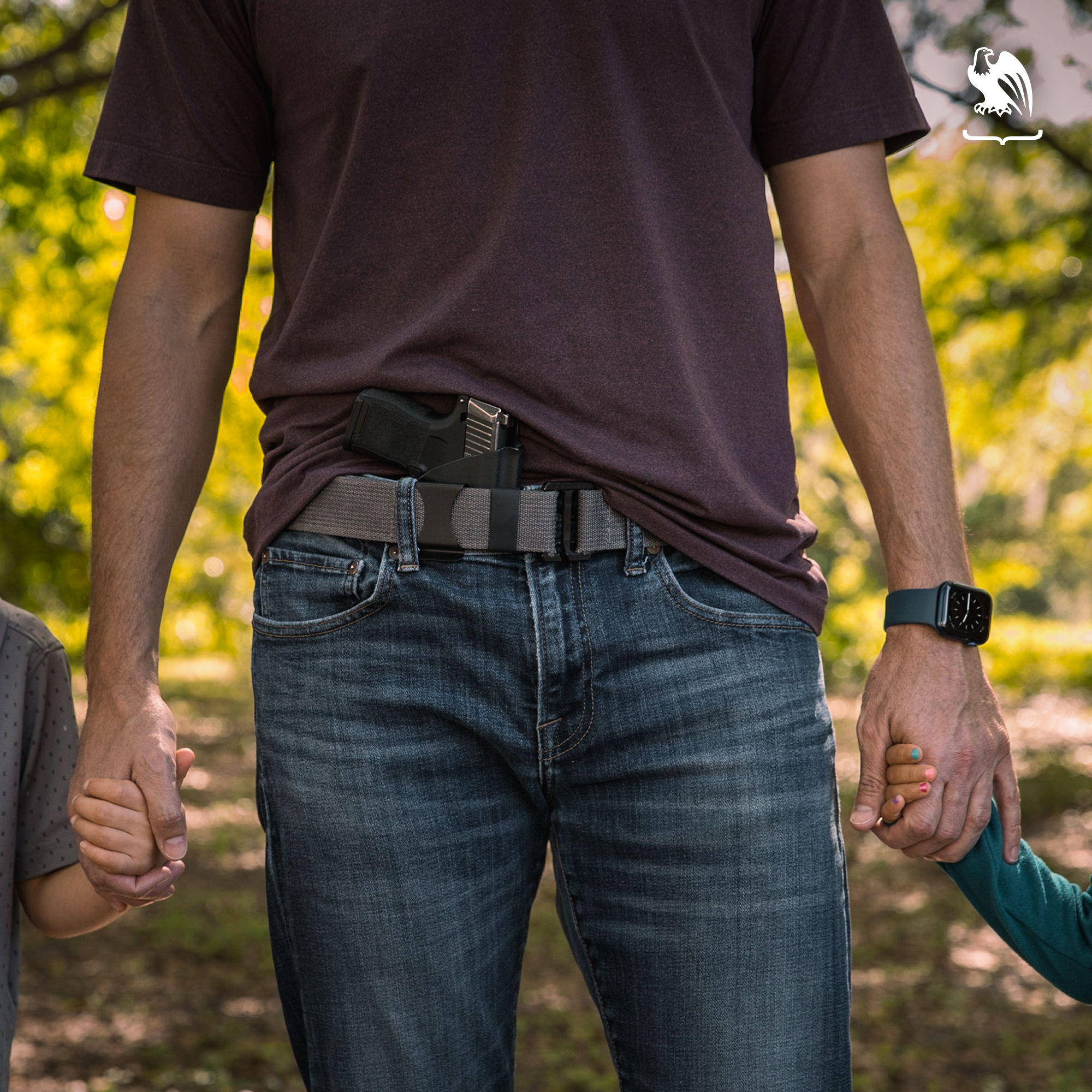
You’ve probably heard that AIWB carry is unsafe since your gun is essentially pointed at your crotch all day. So, let’s address the age-old question: If you carry appendix, will you shoot your junk off?
The short answer to this question is that it depends. As with anything firearms-related, without the proper techniques and training, there is always a chance of getting hurt. But the good news is that appendix carry is not necessarily any more or less dangerous than any other carry position.
As to whether you could actually shoot off your manly bits, we suppose you could if you tried hard enough, but as long as you have quality equipment and practice safe habits, it’s highly unlikely. In fact, with the right gun and holster combo, the muzzle shouldn’t be pointed at your groin at all.
That being said, your pistol probably is pointing right at your femoral artery when carrying AIWB. In case you don’t know, this is one of the last parts of your body you’d want in the way of a negligent discharge, as severing it can be deadly.
While this may sound scary, and it is, you can also minimize the risk of such a tragedy to almost zero with the right equipment, training, and awareness.
The vast majority of personal injuries that occur as a result of negligent or accidental discharge while concealed carrying AIWB happen during re-holstering.
If you fail to clear your garment completely or hold your gun incorrectly, your finger or clothing may accidentally get caught on the trigger and cause the weapon to fire. If this were to happen during AIWB carry, you risk shooting your femoral artery.
Luckily, there are specific techniques you can use to avoid pointing the barrel at yourself while holstering AIWB that can help you avoid this issue altogether (which we’ll get into more detail about later on). This, of course, requires regular training to make a habit.
“Appendix carry, in and of itself, is no more dangerous than any other carry technique when one is properly trained and armed with a handgun that lends itself to this method. It is up to each of us to be properly informed and educated,” an article from the NRA reads.
So, as long as you know the techniques for drawing and carrying, AIWB is perfectly safe. In fact, there are many benefits to carrying appendix. Let’s talk about some of the pros and cons of this method next.
Pros and Cons of Appendix Carry
As with most controversial issues, there is a positive and a negative side to carrying in the 1-2 o’clock position.
Appendix Carry Pros
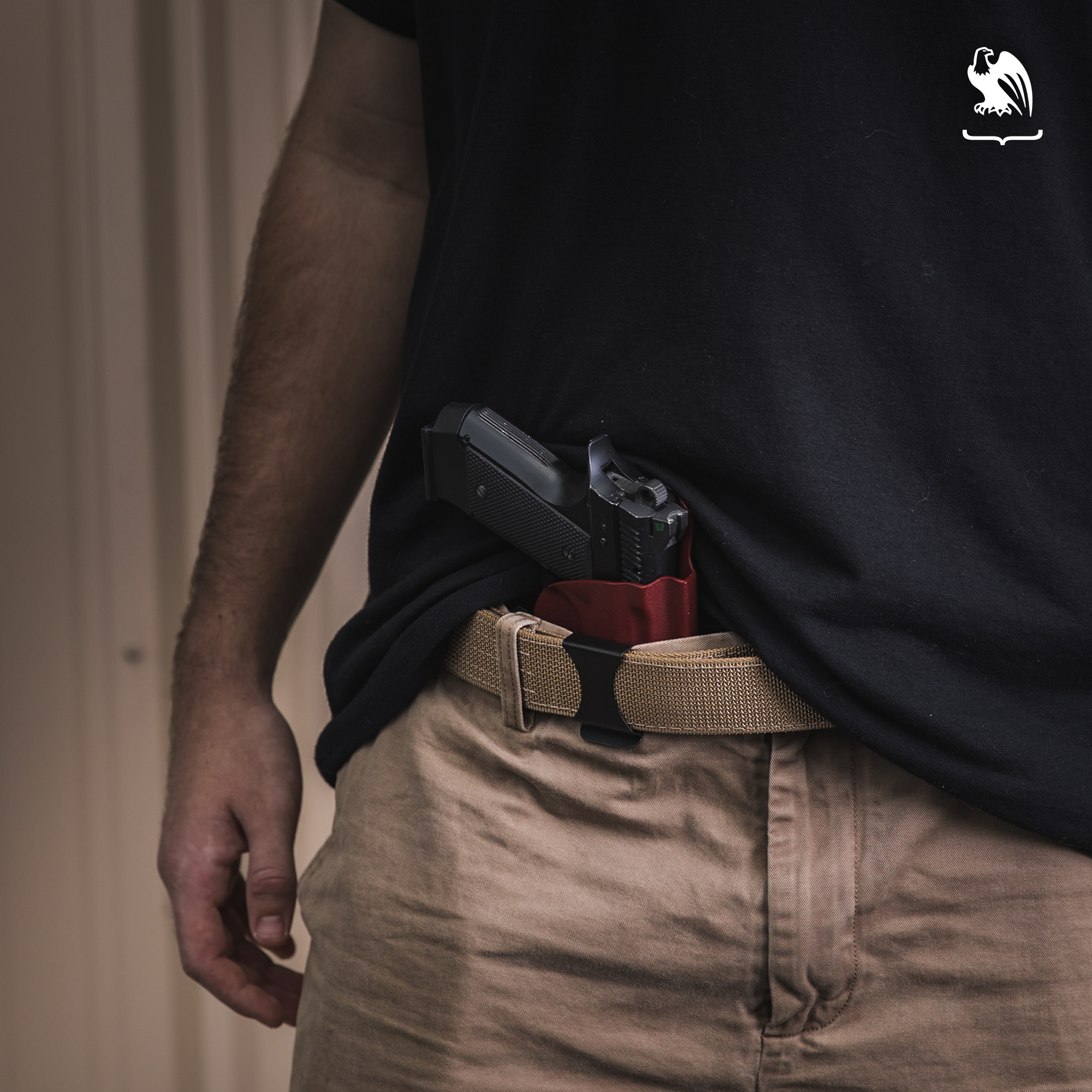
Concealable: First, carrying in this position is incredibly easy to conceal. Paired with the right holster, even a light T-shirt should do the trick.
An adjustable holster can make or break your AIWB experience as it will allow you to play with the placement of your weapon until it disappears under your clothes.
This method is also nice in that you don’t have to worry about your gun being exposed when you bend over. And, as long as you know how to dress for appendix carry (more on that later), reaching and twisting shouldn’t be much of an issue either.
Easy to Access: Accessibility is key when it comes to concealed carry, and the 1-2 o’clock position is by far one of the best in this regard.
The handgun’s location at the front of your body allows you to see what you’re doing as you go to draw, making it easier to fully clear your cover garments and access your pistol.
The only downside to this is that your attacker can also see you’re drawing a weapon, which reduces the element of surprise. Luckily, appendix is also the quickest position to draw from, so it kind of works itself out.
“The natural arm position makes accessing the gun much quicker from the AIWB position than it is when reaching back and behind you. … Extremely talented shooters can achieve draws inside of 1 second using appendix carry while still getting accurate hits on target,” the NRA writes.
Not only that, but this ease of draw offers a tactical advantage in the event of a defensive situation. Self-defense is rarely cut and dried, and the odds are good that you could be cornered, forced to the ground, or wind up in a physical, close-contact fight.
In any of these scenarios, if your gun is on your hip or behind it, it could be next to impossible to access. Whereas if you are carrying appendix, your pistol will always be within reach.
Easier to Retain: When carrying a firearm, it’s your responsibility to use it safely and keep it out of the wrong hands. IWB carry is one of the best ways to do this, as it makes it harder for any would-be snatchers to disarm you. AIWB takes it even a step further by placing the weapon inside your waistband and at the front of your body, so it’s one of the easiest positions to defend.
Appendix Carry Cons
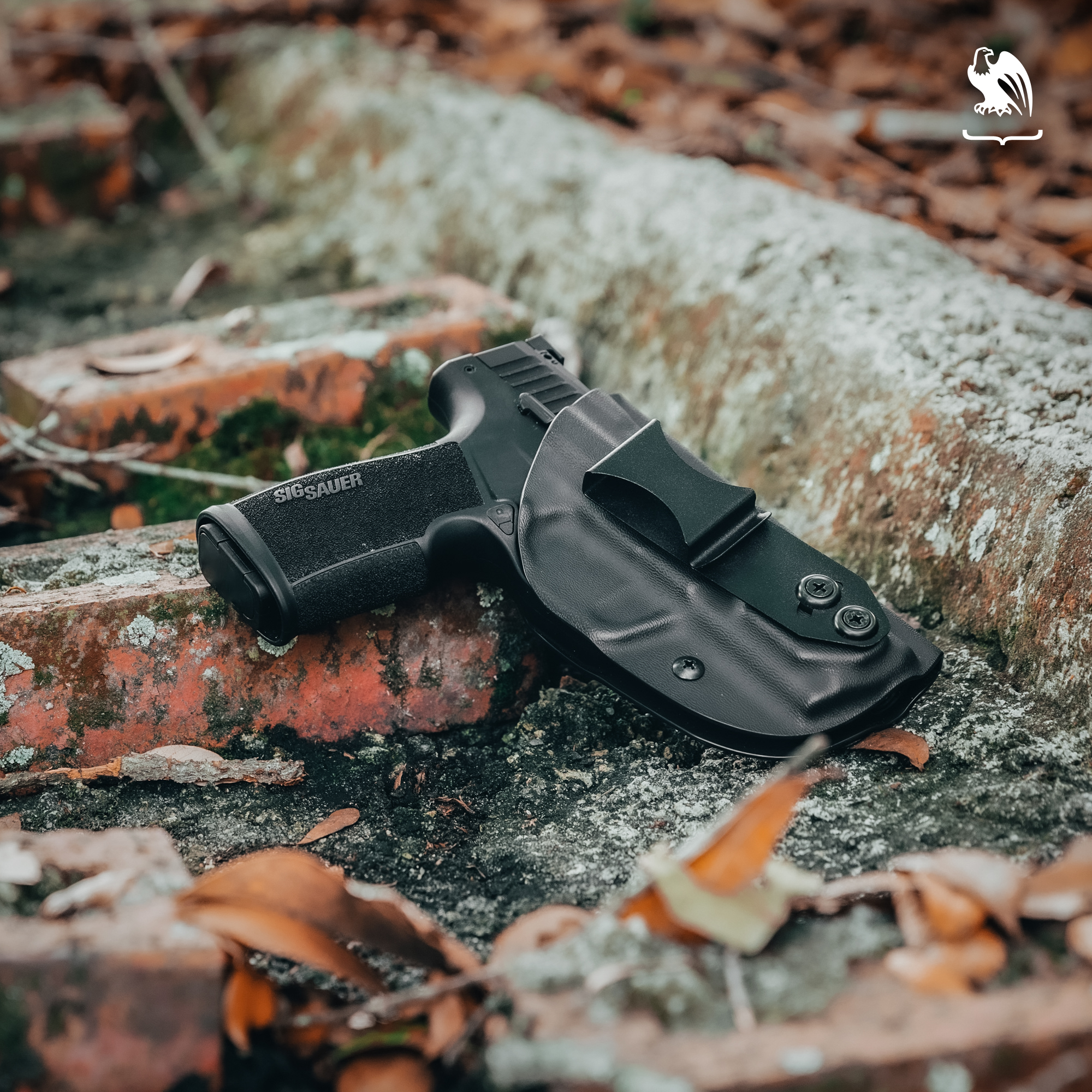
Uncomfortable to Sit: By far, the biggest complaint concerning appendix carry is that it is uncomfortable while seated.
Because of the gun’s positioning at the front of your body, any time you bend over or sit down, that pistol is digging directly into your stomach or thigh. Not all people find this to be the case, especially if you carry a smaller piece, but it can be all but impossible to sit for long periods if you do. Luckily, the right handgun and holster combo can help mitigate this issue.
Safety Risks: Another common issue people have with AIWB is the safety factor. We’ve already discussed this in our article so far, but it bears repeating: appendix carry without a proper gun belt, holster, and training can be risky.
Because of where your muzzle points, if you experience a negligent discharge as you draw or holster your weapon, you could shoot through your femoral artery, which is deadly. Luckily, this is an extremely uncommon occurrence, and practicing good gun safety habits can reduce the risk to almost nothing. But it is certainly an issue to be mindful of and one that discourages some from trying the position altogether.
Obvious Draw: The only other downside to AIWB carry is that you can’t really hide the fact that you’re drawing from someone. If your firearm is located either on or behind your hip, you can kind of hide the fact that you have it for a moment from someone who isn’t aware that it’s there. With your pistol on the front of your body, however, that is next to impossible.
“When someone moves to defeat their cover garment and draw from the appendix position, it is pretty clear that person is trying to access their firearm from their holster,” according to a Tactical Hyve article. “In contrast, if one carried their gun along their hip, one could better disguise or hide the draw from a threat.”
While all of the aforementioned downsides to AIWB carry are significant, most of them can be mitigated by wearing the right holster, learning to draw and re-holster safely, and adjusting your setup to be more comfortable. Let’s talk about each of these factors next.
How to Appendix Carry Comfortably
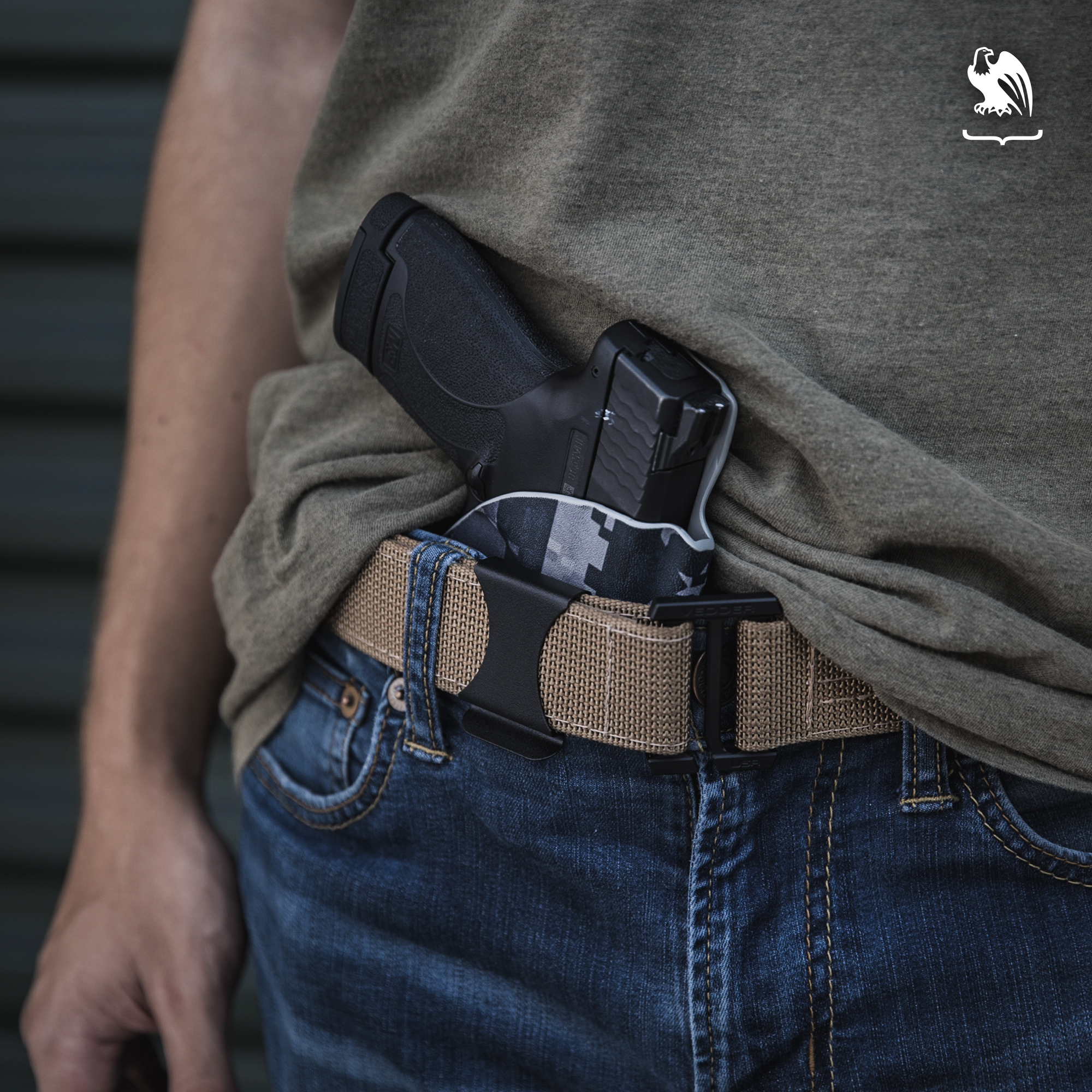
One of the biggest complaints people have about AIWB is that it’s uncomfortable while sitting or bending over. Luckily, we have some tips for how to improve your experience in regards to comfort.
The most critical thing you can do to improve the comfort of carrying appendix is to invest in a quality adjustable holster. The ability to sit with a gun in this position relies almost entirely on being able to adjust the angle of your pistol so that it won’t dig into your body.
We’ll go over more of the specifics of what you should look for in an appendix carry holster next, but for now, just know that you need to look for an AIWB holster with adjustable cant (forward and reverse!), ride height, and retention.
If you find a plain, hard Kydex shell uncomfortable, you may want to consider trying a hybrid AIWB holster. This style is designed with a Kydex shell and a leather backing, which is both comfortable and protective.
Another thing you can do is adjust your positioning slightly. You don’t necessarily have to carry AIWB right at the 1 or 2 o’clock position. You can wear it at the 1:30 position or even the 2:45 position. We promise it’s okay!
Making a few lifestyle adjustments can make carrying appendix easier as well. Good posture will go a long way in ensuring a comfortable AIWB experience. If you work in an office, you may even want to go so far as to invest in a standing desk.
Our final tip has to do with gun size. We know you’re attached to your carry pistol, but you can always consider swapping it for a smaller one for the sake of comfort. Obviously, a firearm with a large grip is way more likely to dig into your stomach than a nice, compact one.
But we’ll talk more about the best guns for this method soon. First, let’s jump into how to pick the right holster.
How to Choose an Appendix Holster
We’ve talked a lot about the importance of using a quality appendix carry holster in this article already. So what exactly are you supposed to look for in an AIWB holster?
Material

The first thing to think about is your holster material. There are four main types of holsters: leather, nylon, Kydex, and hybrid.
Because most appendix carry accidents happen during holstering, nylon and leather holsters are not recommended. These holsters tend to collapse once your pistol is removed, making it more difficult to re-holster.
This is where Kydex comes in. These holsters are made from durable thermoplastic and are designed for a specific model. You can easily holster your weapon with one hand, and your gun will securely click into place. And, despite being a hard shell, Kydex holsters like the Vedder LightTuck™ are surprisingly comfortable.
If you’d like the best of both worlds, a hybrid holster, which offers the comfort of a leather backing and the security of a Kydex shell, is always a great option. The Vedder Holsters RapidTuck™ is a great hybrid option for AIWB, thanks to its lightweight design.
If you plan to carry a spare magazine, the SideTuck AIWB holster will be a great option for you. This Kydex holster comes with an attached mag carrier and is specifically designed for appendix carry.
Adjustability
Most Kydex holsters come with a few adjustable options. This ensures you can find that “sweet spot” for comfort and concealment that works with your body and clothing choices. For appendix carry holsters, it’s important to look for adjustable cant, ride height, and retention.
For the 1-2 o’clock position specifically, adjustable cant is the most critical feature concerning comfort and concealment. As firearms expert Nate Parker writes in a piece for USA Carry, finding a holster with reverse cant can do wonders in finding the perfect spot.
“Typically when we talk about canting holsters, we think of canting the butt of the gun forward when carried in a traditional 3-4 o’clock position,” he writes. “With appendix carry, canting the gun in the opposite direction can be of incredible usefulness. … Using reverse cant on the holster allows me to put the muzzle of the gun where I want it, closer to the centerline, but keep the grip of the gun where I want it too.”
Not all holsters are designed with forward and reverse cant, so it’s essential to make sure yours does. The LightTuck™ makes an excellent appendix carry holster as it is built with 30 degrees of cant in both directions, which is significantly more than most other appendix carry holsters on the market.
Adjustable ride height also plays a role in how comfortable and easy to conceal your weapon is. This allows you to choose either deep concealment or to have your gun ride higher on your waistband, depending on your preference.
Holster Claw
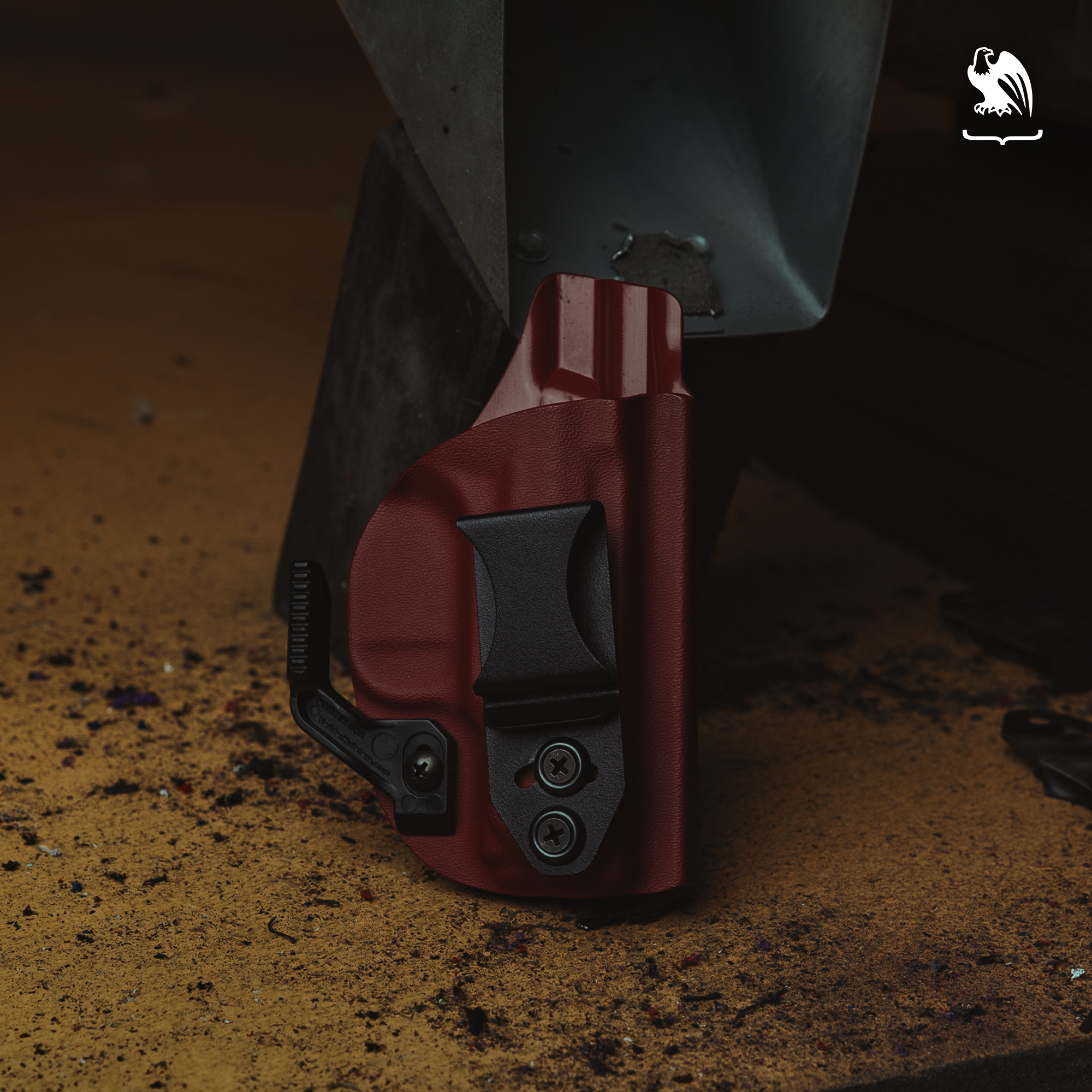
If there’s one accessory that can do wonders in aiding in concealment and comfort, it’s a holster claw or “wing.” These pieces attach to your holster and press against your gun belt to keep everything more secure.
They work by helping to distribute the weight of your firearm and draw the grip closer to your body, which helps reduce printing.
You can check out our Holster Claw Add-On Kit here. It really is the holy grail of holster accessories.
Safety
Last but certainly not least, safety. You already know that there are a few risk factors when it comes to carrying AIWB, so ensuring your holster is as safe as possible should be a priority.
The first thing to look for is a fully covered trigger guard. Because most negligent discharges happen when your shirt or finger accidentally makes contact with the trigger, having a holster that completely protects it will go a long way in helping to prevent an accident.
This is also where adjustable retention comes into play. Retention allows you to adjust how tightly the holster holds on to your gun and how easy it is to draw. It’s important that you adjust your retention to be tight enough to prevent your firearm from slipping yet loose enough to quickly draw from.
How to Safely Re-holster While Carrying AIWB
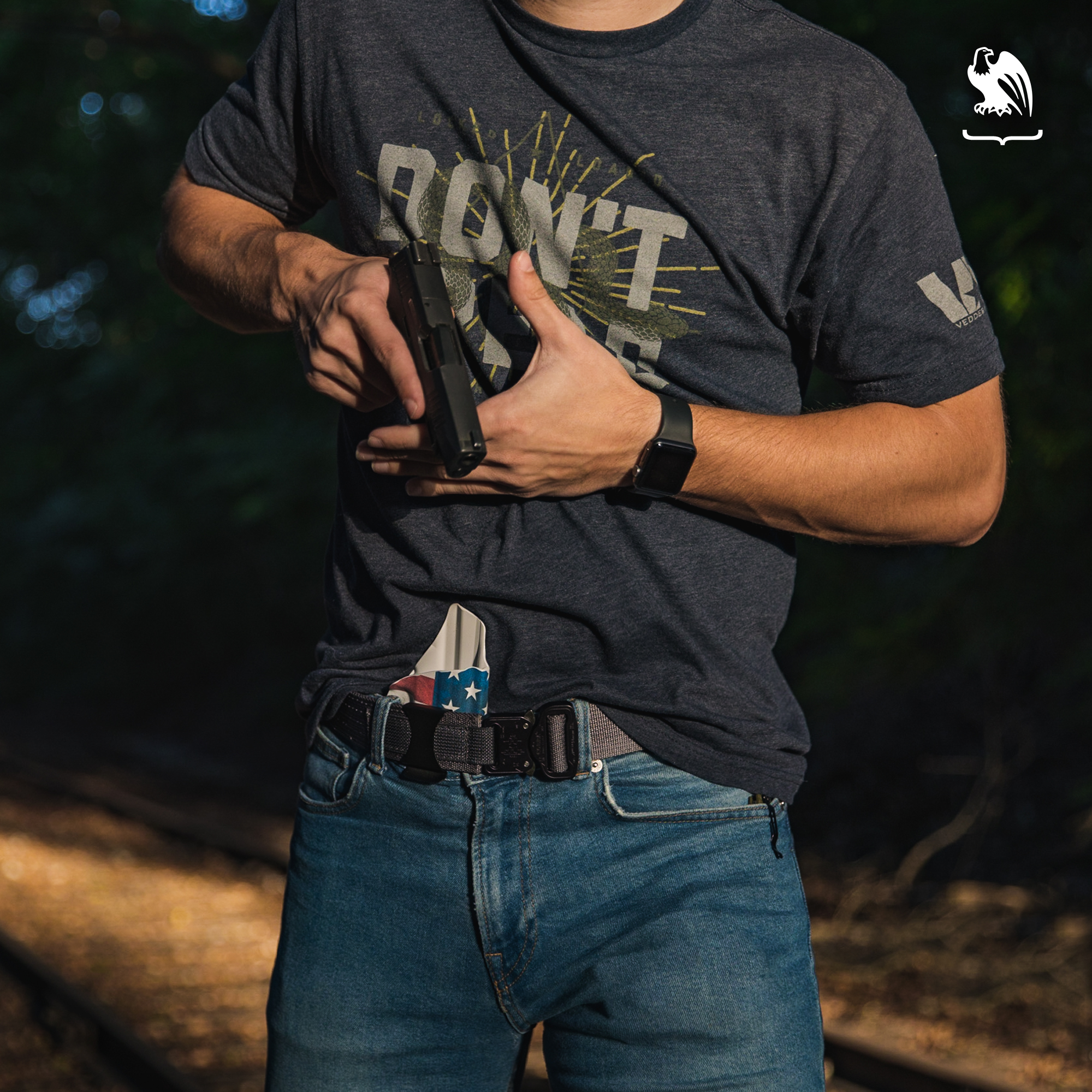
At last, we’ve reached the section about how to safely holster your weapon while carrying AIWB.
As we’ve already established, holstering is when a negligent discharge is most likely to occur, as your clothing or finger may make its way onto the trigger. When this happens in the 1-2 o’clock position, the results can be tragic.
Luckily, with the correct technique and practice, the risk of this happening can be reduced to almost zero. How, you ask? Well, there are a few tips to keep in mind.
First and foremost, the most important thing to remember is to keep your finger off the trigger during these steps. No exceptions.
Next, follow these four simple steps for safely re-holstering your weapon:
- Do not rush. If you’re putting your gun back into its holster, there is no urgency to do so quickly. Take your time, and be intentional.
- Clear your cover garment completely. And by completely, we mean get every inch of fabric out of the way by pulling it up nice and high toward your face with your non-dominant hand. Trust us, you do not want a part of your shirt getting wrapped up in your gun and reaching your trigger.
- Lean back. The easiest way to do this is by placing one foot slightly behind you, shifting your weight back, and tilting your hips forward. It may feel silly, but this is a crucial step as it ensures the barrel will be pointing at the ground, not at your body, as you re-holster. So, if by some chance the gun does go off, it should miss you entirely.
- Insert your pistol into the holster until you hear it click into place.
It’s important to practice these steps at home regularly with an unloaded weapon so that it becomes a habit. You should train often enough that you'll do it automatically if you need to re-holster while out and about.
How to Dress to Carry Appendix
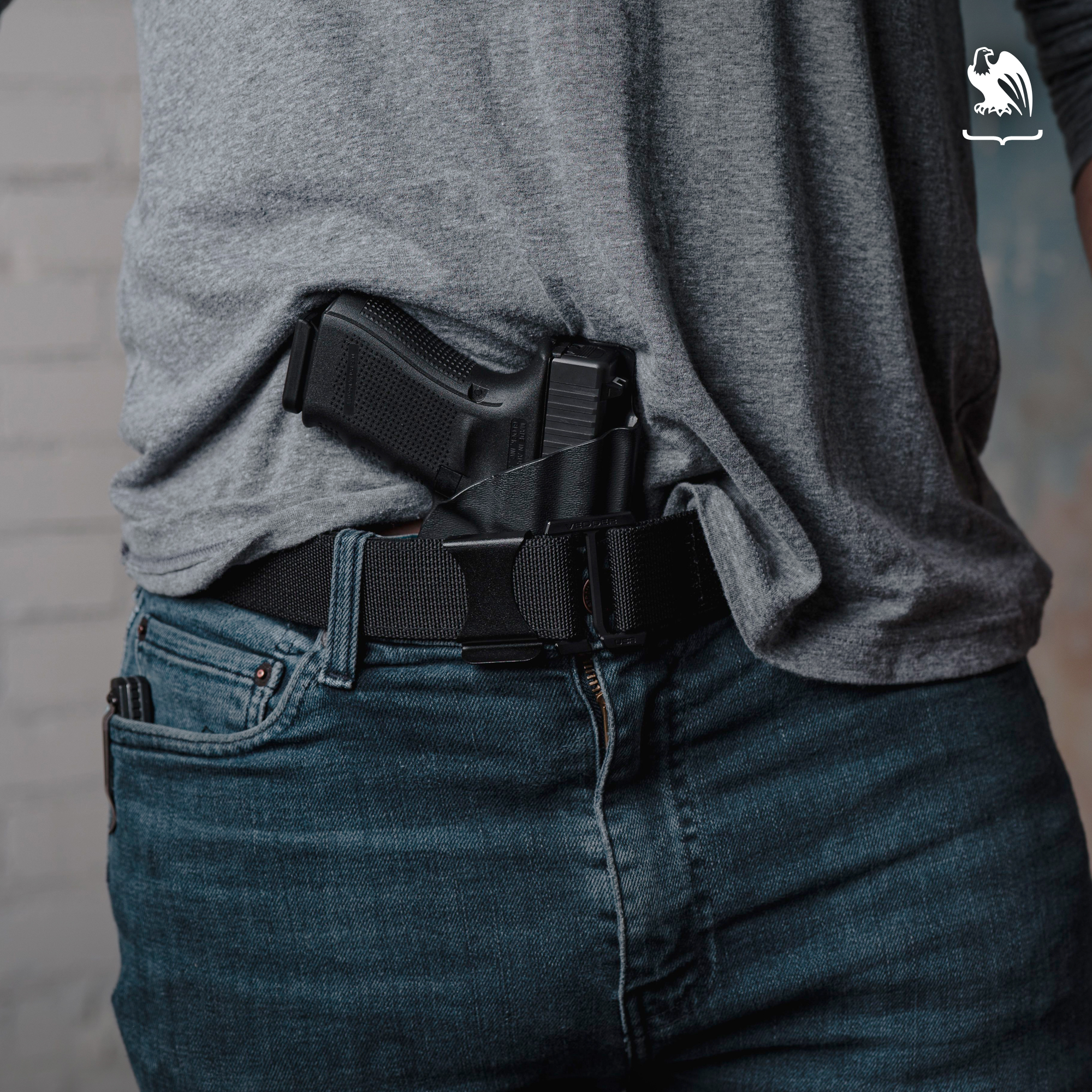
Luckily, appendix is by far one of the easiest waistband positions to dress for.
Because your weapon is positioned at the front of your body, where you don’t have any bones, angles, or curves to work around, you can be much more flexible with your clothing options.
Otherwise, dressing for AIWB is essentially the same as dressing for any other carry method. Looser shirts, larger pants, dark colors, prints and patterns, and shirts with embellishments are ideal for keeping your firearm hidden.
One of the major differences between appendix carry and other positions is that it’s more difficult to use a cover garment to aid in concealment. While yes, a flannel, vest, or jacket that is buttoned or zipped up does the same job, leaving these articles open in the front doesn’t do much for concealing a gun at the front of your body like it does for other techniques.
But perhaps the most significant aspect of dressing for AIWB is your gun belt. A proper EDC belt is essential for any carry position, and this is especially true for appendix carry. Gun belts are designed to be thicker, stiffer, and made from better materials to prevent belt sag. A regular belt, however, may allow your pistol and holster to droop and become visible.
The only issue with gun belts in respect to AIWB carry is that the thick, sturdy buckle found on most EDC belts can add a lot of bulk to the front of your body where you’re already trying to hide a firearm and holster.
Luckily, there is an easy fix for this. If you position your gun belt so that the buckle is situated off to the side of your body instead of in its traditional spot at the front, you can reduce a lot of bulk that would otherwise take place.
If you’re in need of a quality EDC belt, we offer several low-profile tactical belt options, as well as a leather belt made with stiff, high-quality materials guaranteed to keep your weapon where you want it and look great too.
Best Guns for Appendix Carry
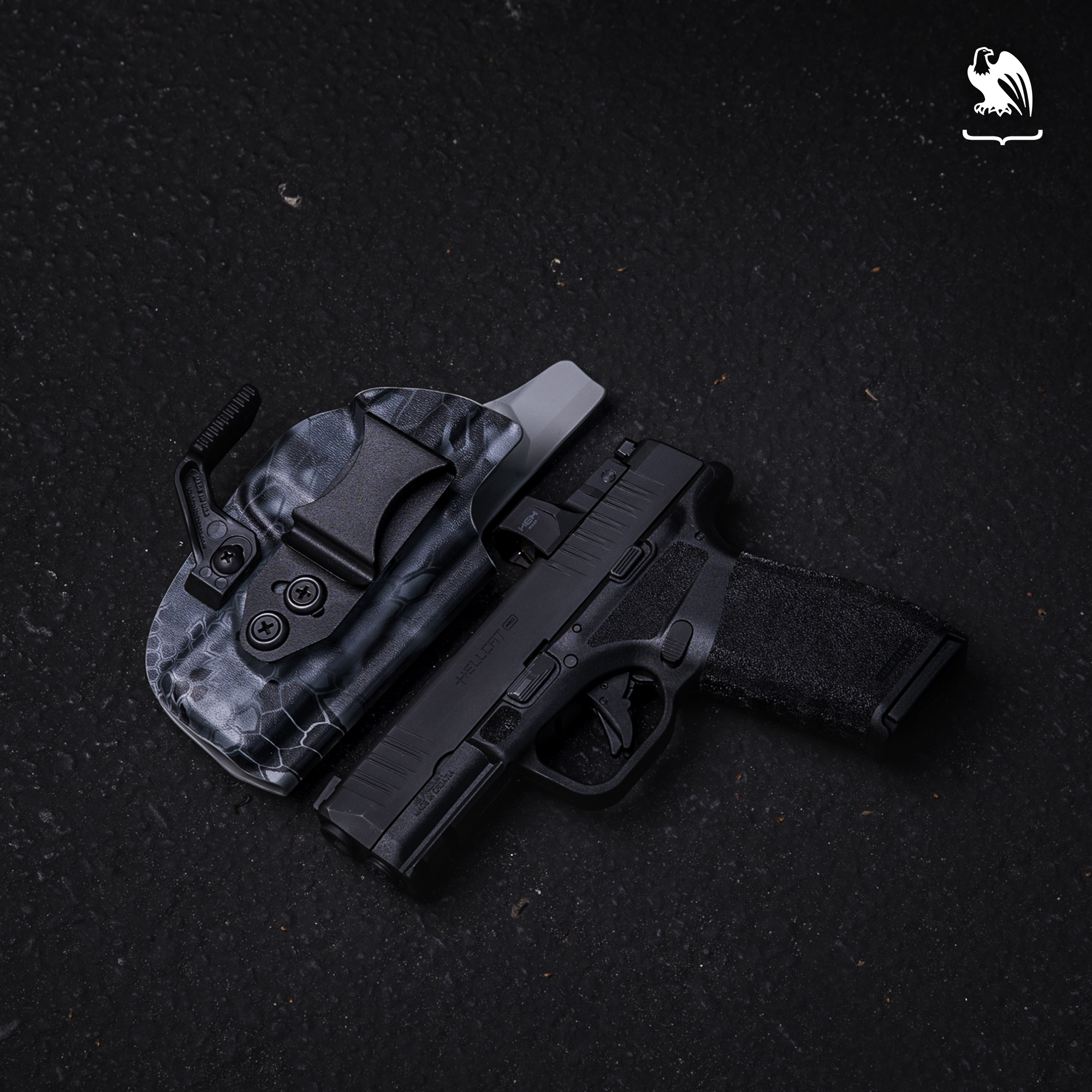
Carrying the right gun can make a big difference in the success of your concealed carry ventures.
For the most part, the weapons that work for AIWB carry are the same that work well for all positions. Traditional dual-action and single-action semi-automatic pistols and semi-automatics with a manual safety are a pretty safe bet.
According to Shooting Illustrated, single- and double-action firearms work well for AIWB because you can place your thumb over the hammer to prevent an accidental discharge while holstering.
As far as size goes, while compact and micro-compact guns work well, you may be surprised to learn that appendix is actually one of the easiest methods to carry longer pistols in. The reason being that, with appendix, the slide of your barrel fits neatly in the space where your leg meets your pelvis, making them easier to conceal.
Revolvers are also highly recommended for AIWB carry. Jim Wilson writes for NRA Family that revolvers are far more difficult to accidentally discharge, making them one of the safer choices for the 1-2 o’clock position.
“Revolvers, single action or double action, will not easily fire when your finger, or the holster, comes in contact with the trigger. I'm sure it can be done, but you'd really have to work at it and, in the case of the SA revolver, you would have to be re-holstering with the hammer cocked – a move that no one in their right mind should consider,” he wrote.
The best gun for you will depend on your personal preference, body type, and choice of clothing. It may take some time to figure out what works best.
Is Appendix Carry Right for Me?
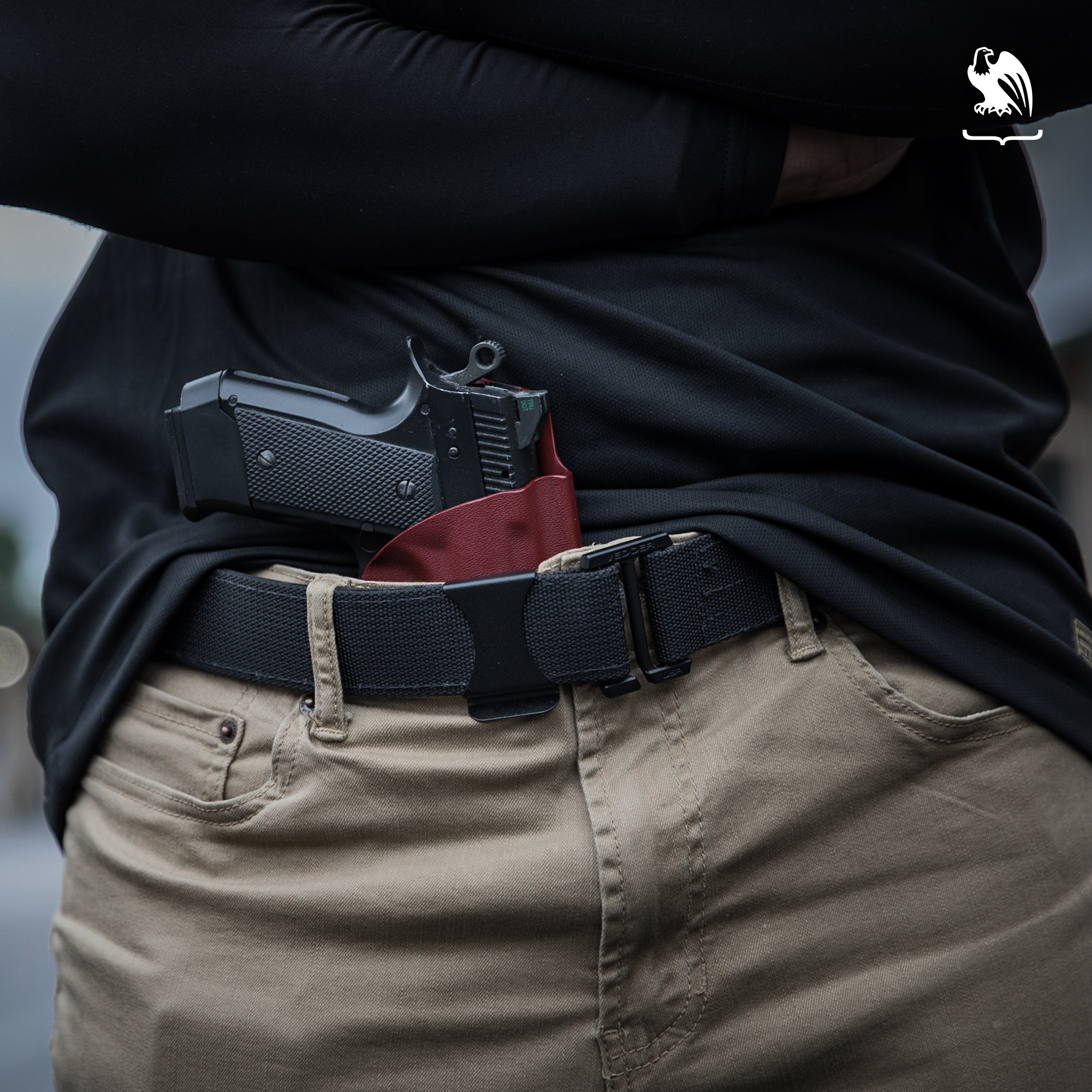
Now that you know the pros and cons of carrying AIWB, it’s time to consider your lifestyle and concealed carry preferences before determining whether you want to try it.
While the decision to carry in the 1-2 o’clock position largely comes down to personal preference, there are a few factors you can take into consideration when deciding whether it is the right move for you.
Body Type
One of the biggest determining factors in whether or not you will find AIWB to be a success is your body type.
People with flatter stomachs and smaller frames tend to enjoy appendix carry. Those with larger middles tend to experience more issues with printing and often find AIWB to be rather uncomfortable.That’s not to say that if you have a beer belly, you can’t successfully carry appendix.
Utilizing a holster claw will do wonders in ensuring your gun stays as close to your body as possible, and an adjustable holster can help you get your pistol in a more comfortable location.
Curves, no matter how much we love them, are not well suited for many concealed carry positions. Guns are square and blocky, and when you try to conceal them over a curved area, it doesn’t usually work well.
For this reason, many women find that AIWB works well for them. Rather than trying to conceal a pistol on your strong side, where a woman’s naturally curved hips cause it to protrude uncomfortably, placing it on your midsection is often easier to conceal.
Daily Activities
Your lifestyle and daily activities play a role in whether you enjoy appendix carry.
For example, most (though not all!) people find sitting for long periods while carrying AIWB extremely uncomfortable. After all, your gun is positioned, so it will likely dig into your leg or stomach while seated.
On the other hand, if you’re on your feet most of the day, appendix is probably one of the best carry options there is.
So, think about all the things you do in your day-to-day. Do you sit, bend over, or have to rotate your body a lot? It may still be worth a try, but you’ll most likely find AIWB to be a miserable experience. If not, it’s probably an excellent choice for you!
Experience
If you’re brand new to CCW, you may want to reconsider trying appendix carry right off the bat.
Even though it’s true that overall AIWB is no more or less dangerous than any other position, certain variables with appendix concealed carry make it a bit riskier.
Because appendix effectively points your gun right at your femoral artery, a wound from a negligent discharge would be far more life threatening than, say, strong side carry (or any other waistband position, really).
While proper holstering techniques and consistent training can negate this added risk, it does take time to work these things into muscle memory. For that reason, it’s probably best to stay clear of the 1-2 o’clock position until you’re confident that you can do so safely.
Trial and Error
At the end of the day, the only way to find out whether or not appendix carry will work for you is just to give it a go. As with any carry method, it may take a day or two to work out any kinks and adjust your holster.
Because of this, we recommend trying AIWB for two to three days to see if it wears in properly. If not, you can always try one of the many other IWB carry positions out there. If you do find you like it, great! Now it’s time to carry often, train consistently, all that good stuff.
Summary
To sum it all up, while there are certain risks associated with appendix carry, this increasingly popular carry position isn’t all that different from the rest. So long as you use the right gear, learn how to holster properly, and train regularly, AIWB carry is a comfortable, safe, accessible, and easy to conceal option.
If you’re looking for belts or holsters, we recommend visiting our Holsters by Gun Model page if you are looking for holsters that are custom-made for your weapon of choice. For all of our belt and holster options and for more information to help you choose the carry system that works best for you, visit our Vedder Holsters website.
Looking for items beyond holsters and belts, check out our Resources Page for popular product links like lights, lasers, first aid, maintenance, and more.



